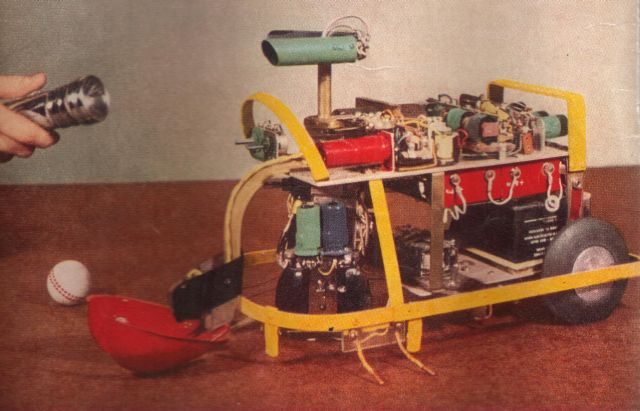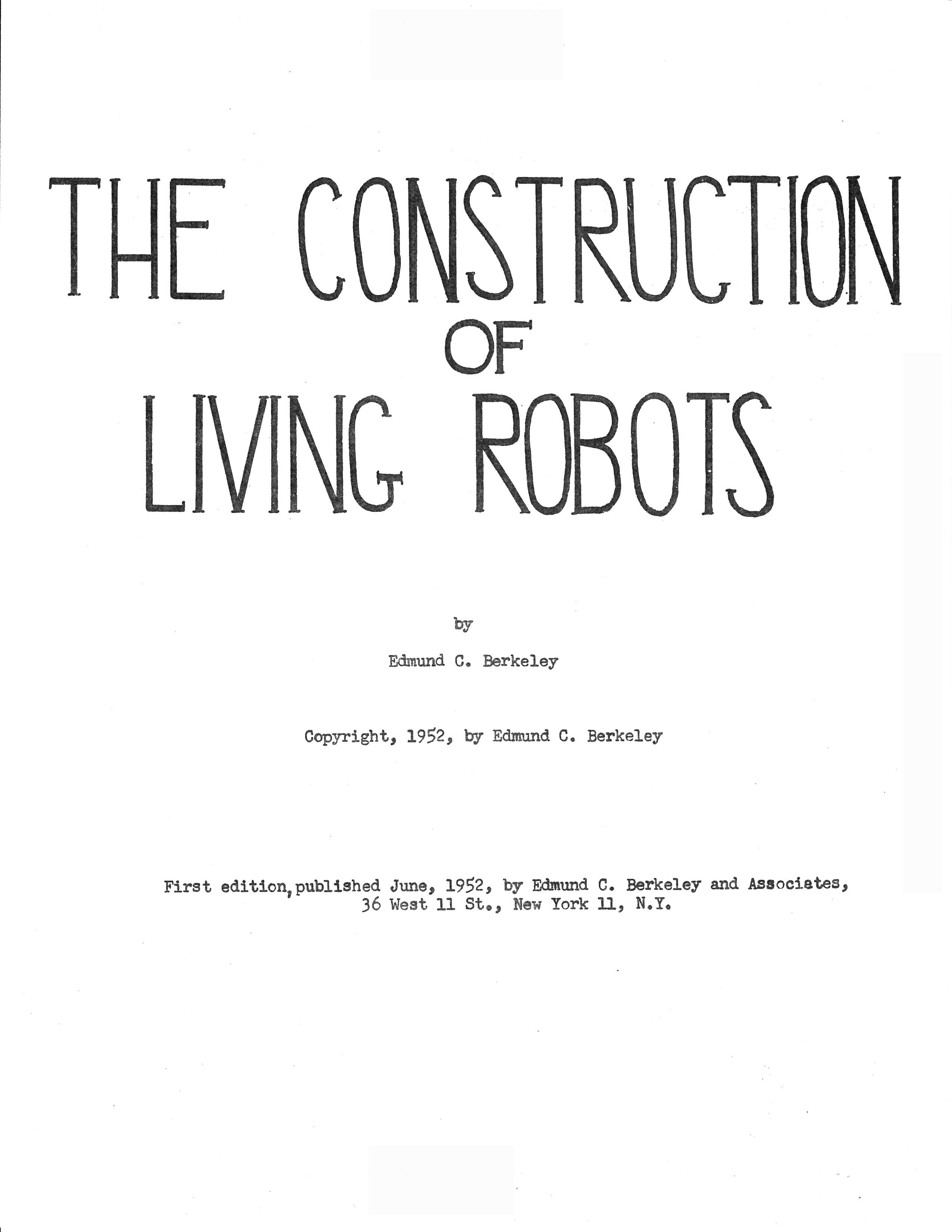Although Squee the electronic squirrel is attributed to Edmund C. Berkeley, Jack Koff (City College of New York engineering student) and Robert "Bob" A. Jensen (until he re-entered the Air Force in June 1951), William Szabo and ECB are all credited with its construction. The opening page from Radio-Electronics mag [Dec, 1951] offers some more info –
"Why did Edmund C. Berkeley and Associates build Squee? Well, last year [1950] Bob Jensen and I read some articles about a mechanical tortoise made in Bristol, England, by Dr. W. Grey Walter at the Burden Neurological Institute. We said to ourselves, "Let's make a robot like that – but have him do something a little more clever." So we came up with the idea of a squirrel gathering nuts, and decided to make a robot squirrel. ……. Bob Jensen made the skeleton, a framework holding a front wheel for driving, a pivoted column holding and steering the wheel, and two rear wheels rolling free. He mounted tubes, relays, and batteries. By October, 1950, the machine was responsive to light (but only to one kind of light). It still had no "hands." In March, 1951, we made a commitment to exhibit …..Squee at the Minnesota State Fair, August 25 to September 3, under the auspices of The Daytona Co., a large department store in Minneapolis [see newspaper clipping below]. The project that had started as fun became good business. We undertook in earnest to work of making the machine sensitive to a second kind of light, and to give it the needed hands. The scheme for the scoop and the nest light was the main contribution of Szabo, and the final completion, testing, and modification of the machine was due to Jack Koff. Squee was exhibited ten hours a day for ten days in Minneapolis, and probably 50,000 people saw him."
From an earlier post here, Berkeley wanted to build Grey Walter's version of the tortoise, but Grey did not have suitable schematics and instruction notes. This had to wait until 1953 when "The Living Brain" was published.
Here is the pdf on the full construction of Squee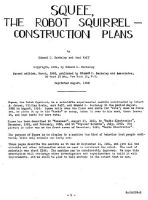
Berkeley put together a report on his offerings:
See:
SMALL ROBOTS — REPORT,
Edmund C. Berkeley,
Copyright 1956 by Berkeley Enterprises, Inc.,
Published April, 1956, by Berkeley Enterprises, Inc.,
815 Washington St., Newtonville 60, Mass.
http://www.blinkenlights.com/classiccmp/berkeley/report.html
extract
Squee (named after "squirrel") is an electronic robot squirrel. It contains four sense organs (two phototubes, two contact switches), three acting organs (a drive motor, a steering motor, and a motor which opens and closes the scoop or "hands"), and a small brain of half a dozen relays. It will hunt for a "nut". The "nut" is a tennis ball designated by a member of the audience who steadily holds a flashlight above the ball, pointing the light at Squee. Then Squee approaches, picks up the "nut" in its "hands" (the scoop), stops paying attention to the steady light, sees instead a light that goes on and off 120 times a second shining over its "nest", takes the "nut" to its "nest", there leaves the nuts, and then returns to hunting more "nuts". When Squee is operating, it is a dramatic and exciting example of a robot. It has been exhibited in New York, Pittsburgh, and Minneapolis, and has always entertained and excited the audience. The machine however is sensitive to the surrounding light level, and usually has to be shown in a room about 8 by 10 ft. with only a small amount of overhead light and black curtained walls. Data: completed; rather well finished but not professionally; 75% reliable; maintenance, difficult; our costs, about $3,000.
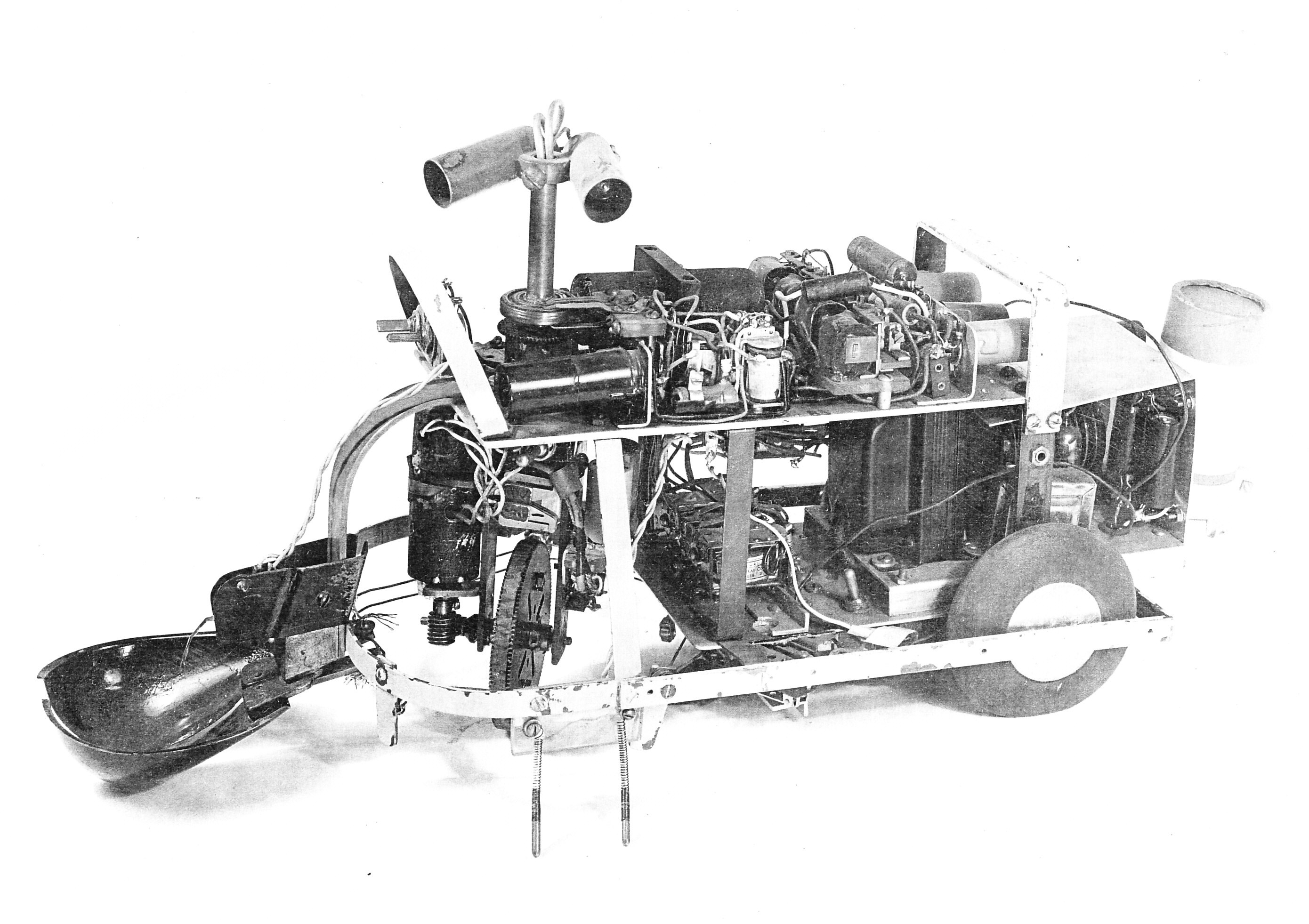
There is another relatively unknown paper produced by Berkeley titled "The Construction of Living Robots" (1952). I feel this was inspired by Grey Walter's Scientific American paper "An Imitation of Life" . Here's the front page. I think it is significant enough to publish here. Here's the pdf' – LivingRobots52
For the full copy of the Radio Electronics article see my contribution here kindly hosted by my friend David Buckley.
Popular Science July 1952 (below)
Pic below – Berkeley with Squee – now hooked up to mains power (notice power lead) – (Source: Life Mag. 19 March 1956).
Below article from "Symbolic Logic and Intelligent Machines" Edmund C. Berkeley 1959.
Squee as it is today. [mains powered, and eyes pointing backward] – part of the Gordon and Gwen Bell collection.
See some recent pics at the Computer History Museum here.
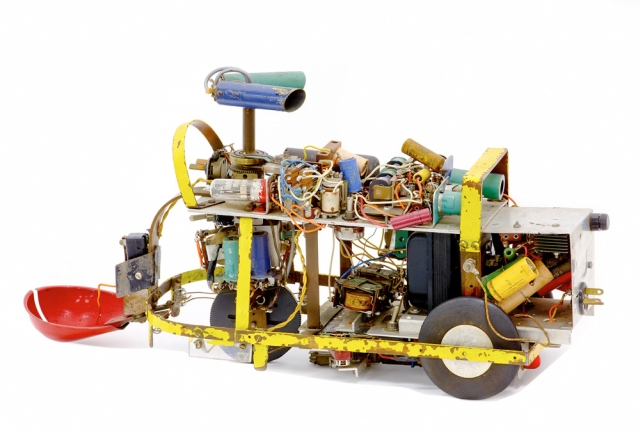
Now on loan to the Computer History Museum. Note the two "feelers", known as the "foot" have been removed or broken off.
From Squee, The Robot Squirrel – Construction Plans, 1952
p2 "The squirrel has two photocell "eyes", left and right, which see either steady or oscillating light. While hunting, the squirrel pays no attention to the oscillating (nest) light, only to the steady light illuminating the "nut". When a "nut" is picked up, the squirrel homes towards the nest. The nest is a sheet of metal on the floor. when the squirrel arrives there, two probes on the base of the squirrel (the "foot" switch) close a contact, the scoop opens, the ball rolls out, and the squirrel backs away from the nest. The squirrel then forgets about its nest, and goes back hunting for another nut.

TRIVIA: 1. Dr. W. Grey Walter called his own tortoises either Machina Speculatrix (M. speculatrix for short) or M. Docilis as mock biological names. He subsequently named Berkeley's Squee as M. speculatrix berkeleyi (ref –The Living Brain – Grey Walter p118).
2. In 2009, David Buckley and I visited Grey Walter's tortoise held in the British Science Museum. During our detailed study of it, we noticed that the photo-cell shroud was actually put on in reverse to make it look as if it was going forward. We manually rotated the scanning assembly 180deg, corrected the shroud, and now anyone taking a photo of it will get the correct orientation of the front assembly.
I wish someone would rotate Squee's scanner to make it point forward, not backward!
